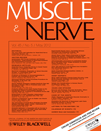Electrical impedance myography in spinal muscular atrophy: A longitudinal study
Abstract
Introduction: New approaches for assessing disease progression in spinal muscular atrophy (SMA) are needed. In this study, we evaluate whether electrical impedance myography (EIM) can detect disease progression in SMA compared with a group of healthy children of similar age. Methods: Twenty-eight children with SMA and 20 normal children underwent repeated EIM testing in four muscles at regular intervals for up to 3 years. An average rate of change of EIM was calculated for each subject and normalized to subcutaneous fat thickness and muscle girth. Results: Multiple EIM parameters showed a change in normal subjects over a mean of 16.7 months; however, no change was found in SMA patients over this period. Conclusions: EIM could detect non–mass-dependent muscle maturation in healthy children. In contrast, the muscle in children with SMA, as measured by EIM, was virtually static, showing no evidence of growth or active deterioration. Muscle Nerve, 2012




